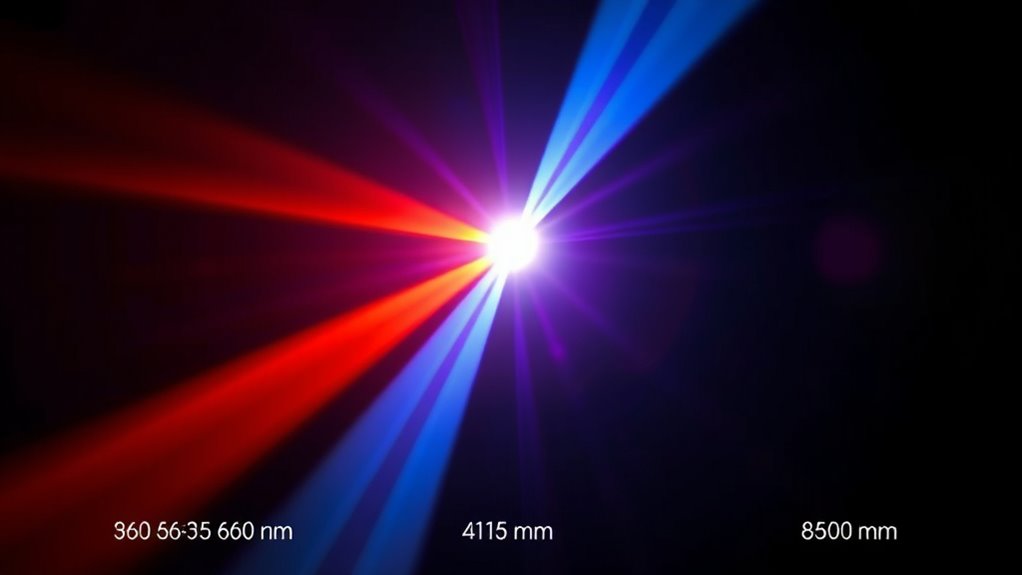When choosing between 630–660 nm, 415 nm, and 850 nm wavelengths, consider your treatment goals. The 630–660 nm spectrum works well for superficial skin issues, promoting targeted effects with limited deep tissue penetration. The 415 nm wavelength, absorbed highly by pigments and bacteria, is ideal for superficial applications like pigmentation or sterilization. The 850 nm wavelength penetrates deeply, making it suitable for deep tissue therapy and healing. Understanding these differences helps you select the best option—continue to explore how each wavelength can meet your specific needs.
Key Takeaways
- 630–660 nm targets superficial tissues, ideal for dermatology and minor skin procedures with minimal deep damage.
- 415 nm is suitable for superficial applications like pigmentation treatment and sterilization due to limited tissue penetration.
- 850 nm penetrates deeper into tissues, making it effective for deep tissue therapies like pain relief and cellular healing.
- Proper wavelength selection aligns with treatment depth and tissue interaction for optimal safety and efficacy.
- Matching laser wavelength to specific therapeutic goals ensures effective outcomes while minimizing collateral tissue damage.

Selecting the right frequency is essential for effectively communicating your message and reaching your target audience. When it comes to laser technology, understanding how different laser wavelengths influence tissue penetration is vital. Each wavelength interacts uniquely with biological tissues, determining how deep the laser energy can travel and what effects it can produce. For example, a laser wavelength of 630-660 nm is in the visible red spectrum, offering moderate tissue penetration. This range is often used in applications like dermatology and minor procedures because it provides enough penetration to target superficial tissues without affecting deeper layers. If you’re aiming for surface-level treatments, this wavelength ensures precise targeting while minimizing damage to underlying tissues.
Choosing the right laser wavelength ensures effective treatment while minimizing tissue damage.
In contrast, a 415 nm laser operates in the violet-blue spectrum, offering limited tissue penetration. Its primary advantage lies in its high absorption by specific chromophores like melanin and bacterial pigments. This makes it particularly useful for skin conditions, pigmentation treatments, or sterilization, where superficial application is sufficient. Since the laser energy doesn’t penetrate deeply, it’s less effective for targeting deeper tissues but excellent for surface-level effects. When choosing this wavelength, you need to consider that its limited tissue penetration allows for targeted action on superficial layers, reducing the risk of collateral damage.
On the other hand, an 850 nm laser falls into the near-infrared spectrum, providing considerably greater tissue penetration. This wavelength is ideal for deep tissue treatments, such as pain management, physiotherapy, or surgical procedures requiring access to deeper structures. Its ability to penetrate several centimeters into tissue makes it highly effective for stimulating cellular activity, promoting healing, or destroying targeted tissues deep within the body. When selecting this laser wavelength, keep in mind that deep tissue penetration enhances therapeutic outcomes but also necessitates careful control to avoid unintended damage to surrounding tissues.
Ultimately, your choice of laser wavelength should align with your treatment goals and the depth of tissue you need to target. Understanding how each wavelength interacts with tissue penetration helps you optimize your approach, ensuring effective results while maintaining safety. Whether you need superficial precision or deep tissue access, matching the laser wavelength to your specific application ensures you communicate your message effectively—be it a treatment, diagnosis, or therapeutic intervention.
Frequently Asked Questions
How Do Environmental Factors Affect Wavelength Effectiveness?
Environmental factors markedly affect wavelength effectiveness by influencing laser penetration and wavelength absorption. For instance, dust, humidity, or smoke can scatter laser light, reducing its penetration depth and making certain wavelengths less effective. You need to take into account these factors when selecting a wavelength, as ideal wavelengths for specific environments guarantee better absorption and deeper penetration, ultimately improving the laser’s performance and safety.
Can Different Wavelengths Be Combined for Better Results?
They say “two heads are better than one,” and the same applies to wavelengths. Yes, combining different wavelengths can enhance results through wavelength compatibility and multi-wavelength synergy. By using multiple wavelengths together, you target various depths and tissue types more effectively, improving overall efficiency. Just guarantee the wavelengths complement each other and work in harmony, maximizing the benefits of multi-wavelength synergy for your specific application.
Are There Safety Concerns With Specific Wavelengths?
Yes, there are safety concerns with specific wavelengths due to laser safety and wavelength sensitivity. Certain wavelengths, like 415 nm, can pose higher risks of eye damage because of their deep tissue penetration and visibility. Always follow laser safety protocols, wear appropriate protective gear, and comprehend the wavelength sensitivity to prevent accidental exposure. Proper training helps you manage these risks effectively and ensures safe operation of laser devices.
How Does Tissue Type Influence Optimal Wavelength Selection?
Tissue type guides your choice like a map guiding a traveler. You’ll find that different tissues absorb wavelengths uniquely, influencing cellular response. For instance, highly pigmented tissues absorb shorter wavelengths better, making 415 nm ideal, while deeper tissues respond well to longer wavelengths like 850 nm. Understanding tissue absorption helps you select the best wavelength, ensuring effective treatment while minimizing unwanted effects on surrounding tissue.
What Are the Long-Term Effects of Using Each Wavelength?
Using 630-660 Nm, 415 Nm, or 850 Nm wavelengths can impact long-term tissue response and wavelength durability. Over time, the 630-660 Nm wavelength may promote sustained healing, while 415 Nm offers precise tissue targeting with minimal long-term effects. The 850 Nm wavelength, however, could cause deeper tissue changes, potentially leading to longer recovery periods. Your choice influences the tissue’s long-term response and the durability of the wavelength’s therapeutic effects.
Conclusion
Ultimately, selecting the right frequency is like finding the perfect harmony for your needs. While each wavelength offers its unique benefits, trusting your intuition and understanding your goals will guide you to the ideal choice. Think of it as a gentle dance — sometimes a softer step, sometimes a bolder stride. Embrace the journey of discovery, and you’ll uncover the subtle nuances that lead to the best results for you.









